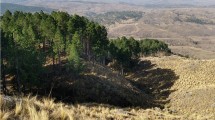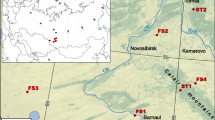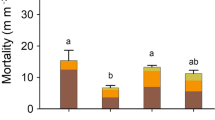Abstract
Aims
Complex topography, a common feature of forested areas, generates unique environmental gradients that may shape root dynamics in unexpected ways. Nevertheless, belowground studies rarely capture the environmental gradients imposed by complex topography, such as those found along hillslopes. This begs the question: how much information is lost when complex topography is ignored? Hillslope is a common aspect of complex topography with landscape features that impact water flow, sediment transfer, and water and nutrient storage. We hypothesized that soil water content would have a nonlinear impact on fine-root production, mortality, standing crop, and turnover. Specifically, we expected increased mortality and decreased production, root standing crop, and turnover at the driest and wettest regions of the hillslope.
Methods
Using minirhizotron observations from 150 tubes located at 50 sites strategically placed at different hillslope positions across a first-order catchment, we examined how position along a hillslope impacts fine root dynamics.
Results
Contrary to our hypotheses, we found no significant hillslope effects on fine root tip production or mortality. Root tip turnover, however, was higher at drier than wetter regions of the hillslope. Additionally, fine root standing crop length was higher in wetter topographic regions.
Conclusions
Considering fine root tip turnover and length standing crop in combination with previous research on fine root lifespan suggest two distinct strategies of trees in root deployment along a hillslope: temporal avoidance in drier regions of a landscape (midslope planar and ridgetops) and extended survival of roots in wetter, deeper-soil regions like valley floor and swales.





Similar content being viewed by others
Data availability
The datasets generated and analyzed for this study can be found in the Susquehanna Shale Hills Critical Zone Observatory Data Site: http://www.czo.psu.edu/data_geospatial.html.
References
Abramoff RZ, Finzi AC (2016) Seasonality and partitioning of root allocation to rhizosphere soils in a midlatitude forest. Ecosphere 7(11):e01547
Baldwin D, Naithani KJ, Lin H (2017) Combined soil-terrain stratification for characterizing catchment-scale soil moisture variation. Geoderma 285:260–269
Bauerle TL, Richards JH, Smart DR, Eissenstat DM (2008) Importance of internal hydraulic redistribution for prolonging the lifespan of roots in dry soil. Plant Cell Environ 31(2):177–186
Bilbrough CJ, Caldwell MM (1995) The effects of shading and N status on root proliferation in nutrient patches by the perennial grass Agropyron desertorum in the field. Oecologia 103(1):10–16
Bloom AJ, Chapin III, Mooney HA (1985) Resource limitation in plants-an economic analogy. Annu Rev Ecol Syst 16(1):363–392
Brooks SP, Gelman A (1998) General methods for monitoring convergence of iterative simulations. J Comput Graph Stat 7(4):434–455
Brown DA, Upchurch DR (1987) Minirhizotrons: A summary of methods and instruments in current use. Minirhizotron observation tubes: methods and applications for measuring rhizosphere dynamics, vol 50, 15–30
Chen W, Zeng H, Eissenstat DM, Guo D (2013) Variation of first-order root traits across climatic gradients and evolutionary trends in geological time. Glob Ecol Biogeogr 22(7):846–856
Comas LH, Eissenstat DM (2009) Patterns in root trait variation among 25 co-existing North American forest species. New Phytol 182(4):919–928
Congdon PD (2019) Bayesian hierarchical models: with applications using R. CRC Press, Boca Raton
Drew MC (1997) Oxygen deficiency and root metabolism: injury and acclimation under hypoxia and anoxia. Annu Rev Plant Biol 48(1):223–250
Eissenstat DM (1992) Costs and benefits of constructing roots of small diameter. J Plant Nutr 15(6–7):763–782
Eissenstat DM, Caldwell MM (1988) Competitive ability is linked to rates of water extraction. Oecologia 75(1):1–7
Gaul D, Hertel D, Leuschner C (2008) Effects of experimental soil frost on the fine-root system of mature Norway spruce. J Plant Nutr Soil Sci 171(5):690–698
Gill RA, Jackson RB (2000) Global patterns of root turnover for terrestrial ecosystems. New Phytol 147(1):13–31
Glenz C, Schlaepfer R, Iorgulescu I, Kienast F (2006) Flooding tolerance of Central European tree and shrub species. For Ecol Manag 235(1–3):1–13
Green JJ, Dawson LA, Proctor J, Duff EI, Elston DA (2005) Fine root dynamics in a tropical rain forest is influenced by rainfall. Plant Soil 276(1):23–32
Guo DL, Mitchell RJ, Hendricks JJ (2004) Fine root branch orders respond differentially to carbon source-sink manipulations in a longleaf pine forest. Oecologia 140(3):450–457
Guo D, Xia M, Wei X, Chang W, Liu Y, Wang Z (2008) Anatomical traits associated with absorption and mycorrhizal colonization are linked to root branch order in twenty-three Chinese temperate tree species. New Phytol 180(3):673–683
Hendricks JJ, Aber JD, Nadelhoffer KJ, Hallett RD (2000) Nitrogen controls on fine root substrate quality in temperate forest ecosystems. Ecosystems 3(1):57–69
Hodges C, Kim H, Brantley SL, Kaye J (2019) Soil CO2 and O2 concentrations illuminate the relative importance of weathering and respiration to seasonal soil gas fluctuations. Soil Sci Soc Am J 83(4):1167–1180
Hu F, Mou PP, Weiner J, Li S (2014) Contrasts between whole-plant and local nutrient levels determine root growth and death in Ailanthus altissima (Simaroubaceae). Am J Bot 101(5):812–819
Huang B, Duncan RR, Carrow RN (1997) Drought-resistance mechanisms of seven warm‐season turfgrasses under surface soil drying: II. Root aspects. Crop Sci 37(6):1863–1869
Jackson RB, Manwaring JH, Caldwell MM (1990) Rapid physiological adjustment of roots to localized soil enrichment. Nature 344(6261):58–60
Jones RH, Mitchell RJ, Stevens GN, Pecot SD (2003) Controls of fine root dynamics across a gradient of gap sizes in a pine woodland. Oecologia 134(1):132–143
Joslin JD, Wolfe MH (1999) Disturbances during minirhizotron installation can affect root observation data. Soil Sci Soc Am J 63:218–221
Joslin JD, Wolfe MH, Hanson PJ (2000) Effects of altered water regimes on forest root systems. New Phytol 147(1):117–129
Kong D, Ma C, Zhang Q, Li L, Chen X, Zeng H, Guo D (2014) Leading dimensions in absorptive root trait variation across 96 subtropical forest species. New Phytol 203(3):863–872
Lee EH, Tingey DT, Beedlow PA, Johnson MG, Burdick CA (2007) Relating fine root biomass to soil and climate conditions in the Pacific Northwest. For Ecol Manag 242(2–3):195–208
Li L, DiBiase RA, Del Vecchio J, Marcon V, Hoagland B, Xiao D et al (2018) The effect of lithology and agriculture at the Susquehanna Shale Hills Critical Zone Observatory. Vadose Zone J 17(1):1–15
Lin H (2006) Temporal stability of soil moisture spatial pattern and subsurface preferential flow pathways in the Shale Hills Catchment. Vadose Zone J 5(1):317–340
Lin HS, Kogelmann W, Walker C, Bruns MA (2006) Soil moisture patterns in a forested catchment: A hydropedological perspective. Geoderma 131(3–4):345–368
Liu B, Li H, Zhu B, Koide RT, Eissenstat DM, Guo D (2015) Complementarity in nutrient foraging strategies of absorptive fine roots and arbuscular mycorrhizal fungi across 14 coexisting subtropical tree species. New Phytol 208:124–136
Ma Z, Guo D, Xu X, Lu M, Bardgett RD, Eissenstat DM, McCormack ML, Hedin LO (2018) Evolutionary history resolves global organization of root functional traits. Nature 555(7694):94–97
McCormack ML, Adams TS, Smithwick EA, Eissenstat DM (2012) Predicting fine root lifespan from plant functional traits in temperate trees. New Phytol 195(4):823–831
McCormack ML, Adams TS, Smithwick EA, Eissenstat DM (2014) Variability in root production, phenology, and turnover rate among 12 temperate tree species. Ecology 95(8):2224–2235
McCormack ML, Dickie IA, Eissenstat DM, Fahey TJ, Fernandez CW, Guo D, Helmisaari HS, Hobbie EA, Iversen CM, Jackson RB, Leppälammi-Kujansuu J (2015) Redefining fine roots improves understanding of below‐ground contributions to terrestrial biosphere processes. New Phytol 207(3):505–518
Naithani KJ, Baldwin DC, Gaines KP, Lin H, Eissenstat DM (2013) Spatial distribution of tree species governs the spatio-temporal interaction of leaf area index and soil moisture across a forested landscape. PLoS One 8(3):e58704
Norby RJ, Ledford J, Reilly CD, Miller NE, O’Neill EG (2004) Fine-root production dominates response of a deciduous forest to atmospheric CO2 enrichment. Proc Natl Acad Sci 101(26):9689–9693
Ntzoufras I (2011) Bayesian modeling using WinBUGS, vol 698. Wiley, Hoboken
Orr AS (2016) Topographic controls on root partitioning patterns in a temperate forest. [dissertation]. The Pennsylvania State University, State College
Plummer M (2012) JAGS Version 3.3. 0 user manual
Pregitzer KS, Hendrick RL, Fogel R (1993) The demography of fine roots in response to patches of water and nitrogen. New Phytol 125(3):575–580
Pregitzer KS, Kubiske ME, Yu CK, Hendrick RL (1997) Relationships among root branch order, carbon, and nitrogen in four temperate species. Oecologia 111(3):302–308
Pregitzer KS, DeForest JL, Burton AJ, Allen MF, Ruess RW, Hendrick RL (2002) Fine root architecture of nine North American trees. Ecol Monogr 72(2):293–309
Prieto I, Armas C, Pugnaire FI (2012) Hydraulic lift promotes selective root foraging in nutrient-rich soil patches. Func Plant Biol 39(9):804–812
Primka IV (2021) E. Fine root dynamics and their effect on soil CO2 efflux across a forested landscape with complex topography. [dissertation]. The Pennsylvania State University, State College
Primka IV, Adams EJ, Buck TS, Eissenstat DM (2021) Topographical shifts in fine root lifespan in a mixed, mesic temperate forest. PLoS One 16(7):e0254672
R Core Team (2021) A language and environment for statistical computing. R Foundation for Statistical Computing, Vienna. https://www.R-project.org/
Ribeiro PJ Jr, Diggle PJ (2006) Analysis of geostatistical data. The geoR package, version, 1–6
Ruess RW, Cleve KV, Yarie J, Viereck LA (1996) Contributions of fine root production and turnover to the carbon and nitrogen cycling in taiga forests of the Alaskan interior. Can J Res 26(8):1326–1336
Ruess RW, Hendrick RL, Burton AJ, Pregitzer KS, Sveinbjornssön B, Allen MF et al (2003) Coupling fine root dynamics with ecosystem carbon cycling in black spruce forests of interior Alaska. Ecol Monogr 73(4):643–662
Santantonio D, Hermann RK (1985) Standing crop, production, and turnover of fine roots on dry, moderate, and wet sites of mature Douglas-fir in western Oregon. In: Anna des Sci For, vol 42, no 2, pp 113–142. EDP Sciences
Schenk HJ, Jackson RB (2002) Rooting depths, lateral root spreads and below-ground/above-ground allometries of plants in water-limited ecosystems. J Ecol 90:480–494
Schielzeth H, Nakagawa S (2013) Nested by design: model fitting and interpretation in a mixed model era. Methods Ecol Evol 4(1):14–24
Smeglin YH, Davis KJ, Shi Y, Eissenstat DM, Kaye JP, Kaye MW (2020) Observing and simulating spatial variations of forest carbon stocks in complex terrain. J Geophys Res Biogeosci 125(1):e2019JG005160
Smith LA, Eissenstat DM, Kaye MW (2017) Variability in aboveground carbon driven by slope aspect and curvature in an eastern deciduous forest, USA. Can J For Res 47(2):149–158
Su Y, Yajima M (2020) Using R to Run ‘JAGS’. Package R2jags
Tingey DT, Phillips DL, Johnson MG, Rygiewicz PT, Beedlow PA, Hogsett WE (2005) Estimates of Douglas-fir fine root production and mortality from minirhizotrons. For Ecol Manag 204(2–3):359–370
Tromp-van Meerveld HJ, McDonnell JJ (2006) On the interrelations between topography, soil depth, soil moisture, transpiration rates and species distribution at the hillslope scale. Adv Water Resour 29(2):293–310
Vogt KA, Vogt DJ, Bloomfield J (1998) Analysis of some direct and indirect methods for estimating root biomass and production of forests at an ecosystem level. Root demographics and their efficiencies in sustainable agriculture, grasslands and forest ecosystems. Springer, Dordrecht, pp 687–720
Wells CE, Eissenstat DM (2001) Marked differences in survivorship among apple roots of different diameters. Ecology 82(3):882–892
Wells CE, Glenn DM, Eissenstat DM (2002) Changes in the risk of fine‐root mortality with age: a case study in peach, Prunus persica (Rosaceae). Am J Bot 89(1): 79–87
Withington JM, Elkin AD, Bulaj B, Olesinski J, Tracy KN, Bouma TJ, Oleksyn J, Anderson LJ, Modrzynski J, Reich PB, Eissenstat DM (2003) The impact of material for minirhizotron tubes for root research. New Phytol 160:1–1
Withington JM, Reich PB, Oleksyn J, Eissenstat DM (2006) Comparisons of structure and life span in roots and leaves among temperate trees. Ecol Monogr 76(3):381–397
Withington JM, Goebel M, Bułaj B, Oleksyn J, Reich PB, Eissenstat DM (2021) Remarkable similarity in timing of absorptive fine-root production across 11 diverse temperate tree species in a common garden. Front Plant Sci 11:2238
Zhou X, Talley M, Luo Y (2009) Biomass, litter, and soil respiration along a precipitation gradient in southern Great Plains, USA. Ecosystems 12(8):1369–1380
Zhu H, Zhao J, Gong L (2021) The morphological and chemical properties of fine roots respond to nitrogen addition in a temperate Schrenk’s spruce (Picea schrenkiana) forest. Sci Rep 11(1):1–12
Acknowledgements
We thank Tyler Wagner for his assistance with Bayesian modeling and Kusum Naithani for deriving spatial orientation of macroplots and minirhizotron tubes. We also thank Jeremy Harper, Molly Pash, and Mitchell Gresock for assistance with TDR construction and installation. Thanks also to Eva Beyen, Kerry Smith, Tiffany Reed, Mitchell Gresock, Myriah Wadley, and Neha Mehta for their assistance in root tracing. Thanks also to Brandon Forsythe for his assistance with precipitation data. The authors would also like to thank Alan Taylor, Erica Smithwick and especially Jason Kaye for suggestions that substantially improved this paper. This manuscript was previously published as part of a dissertation (Primka IV 2021). We also would like to thank Timothy Fahey and the two anonymous reviewers who helped improve this manuscript.
Funding
Support for this work was through the U.S. Department of Energy, Office of Science, Office of Biological & Environmental Research, under Award Number DE-SC0012003. Work was also facilitated through the NSF Critical Zone Observatory program grants EAR – 0725019 (C. Duffy), EAR – 1239285 (S. Brantley), and EAR – 1331726 (S. Brantley). Logistical support and/or data were provided by the NSF-supported Susquehanna Shale Hills Critical Zone Observatory. We also thank USDA National Institute of Food and Agriculture and Hatch Appropriations for their funding under Project #PEN04744 and Accession #1023222. This research was conducted in Penn State’s Stone Valley Forest, which is supported and managed by the Penn State’s Stone Valley Forest, which is supported and managed by the Penn State’s Forestland Management Office in the College of Agricultural Sciences.
Author information
Authors and Affiliations
Contributions
Conceived and designed study: DE. Contributed to revisions: DE, AB, and TA. Performed the study: EP, AB, and TA. Analyzed the data: EP. Contributed materials: DE. Installed instruments: TA, AB, and EP. Wrote the first draft of the paper: EP. All authors contributed to manuscript revision, read, and approved the submitted version.
Corresponding authors
Ethics declarations
Conflict of interest
The authors declare that the research was conducted in the absence of any commercial or financial relationships that could be construed as a potential conflict of interest.
Additional information
Responsible Editor: Timothy J. Fahey.
Publisher’s note
Springer Nature remains neutral with regard to jurisdictional claims in published maps and institutional affiliations.
Rights and permissions
About this article
Cite this article
Primka, E.J., Adams, T.S., Buck, A.S. et al. Shifts in root dynamics along a hillslope in a mixed, mesic temperate forest. Plant Soil 477, 707–723 (2022). https://doi.org/10.1007/s11104-022-05469-3
Received:
Accepted:
Published:
Issue Date:
DOI: https://doi.org/10.1007/s11104-022-05469-3






